What is Schedule Availability? Importance and Key Characteristics

Overview
Schedule availability denotes the precise times when individuals or teams can engage in meetings or collaborative endeavors, playing a pivotal role in enhancing organizational efficiency.
Clear and accessible scheduling information is essential; it significantly reduces communication inefficiencies and conflicts. This improvement not only boosts productivity but also cultivates a collaborative work environment through effective time management practices.
By prioritizing schedule availability, organizations can transform their operational dynamics, ensuring that every team member is aligned and engaged.
Introduction
In today’s collaborative workspaces, understanding the nuances of schedule availability is paramount. Efficient time management can significantly impact productivity, making it essential for organizations to prioritize this aspect. This article examines the critical role of clearly defined schedules, highlighting how they enhance communication, streamline operations, and ultimately drive organizational success.
As teams navigate the complexities of remote work and varying time zones, a pressing question arises: how can organizations effectively manage schedule availability to minimize conflicts and maximize collaboration? The exploration of this issue is vital for fostering a productive work environment.
Defining Schedule Availability
Schedule availability is crucial in today’s fast-paced work environment, which refers to the specific times when individuals or teams are available for meetings, tasks, or collaborative efforts. This concept extends beyond merely identifying unoccupied periods; it emphasizes the clarity and accessibility of scheduling information for all stakeholders. Inefficiencies in communication can lead to significant operational challenges, making effective management of schedule options essential for minimizing conflicts and maximizing productivity. In modern workplaces, where remote work and flexible hours are commonplace, organizations that establish clear time management parameters—such as operational hours and mandatory breaks—can significantly enhance communication and operational efficiency.
For instance, a spa may define its operational hours from 9 AM to 7 PM, incorporating 15-minute buffers between appointments and a mandatory lunch break from 12 PM to 1 PM. This structured approach not only streamlines appointment management but also fosters a more organized work environment. Furthermore, companies that utilize planning software to provide real-time availability updates can reduce missed appointments and enhance overall group productivity. Tools like the ‘Next Available’ button in Outlook facilitate effective navigation of time slots, ensuring that all team members have access to precise planning information.
To further mitigate last-minute conflicts and improve attendance reliability, organizations should consider publishing weekly schedules at least one week in advance. By guaranteeing that all team members have access to accurate schedule availability, companies can cultivate a more collaborative atmosphere, ultimately leading to enhanced employee satisfaction and operational success.
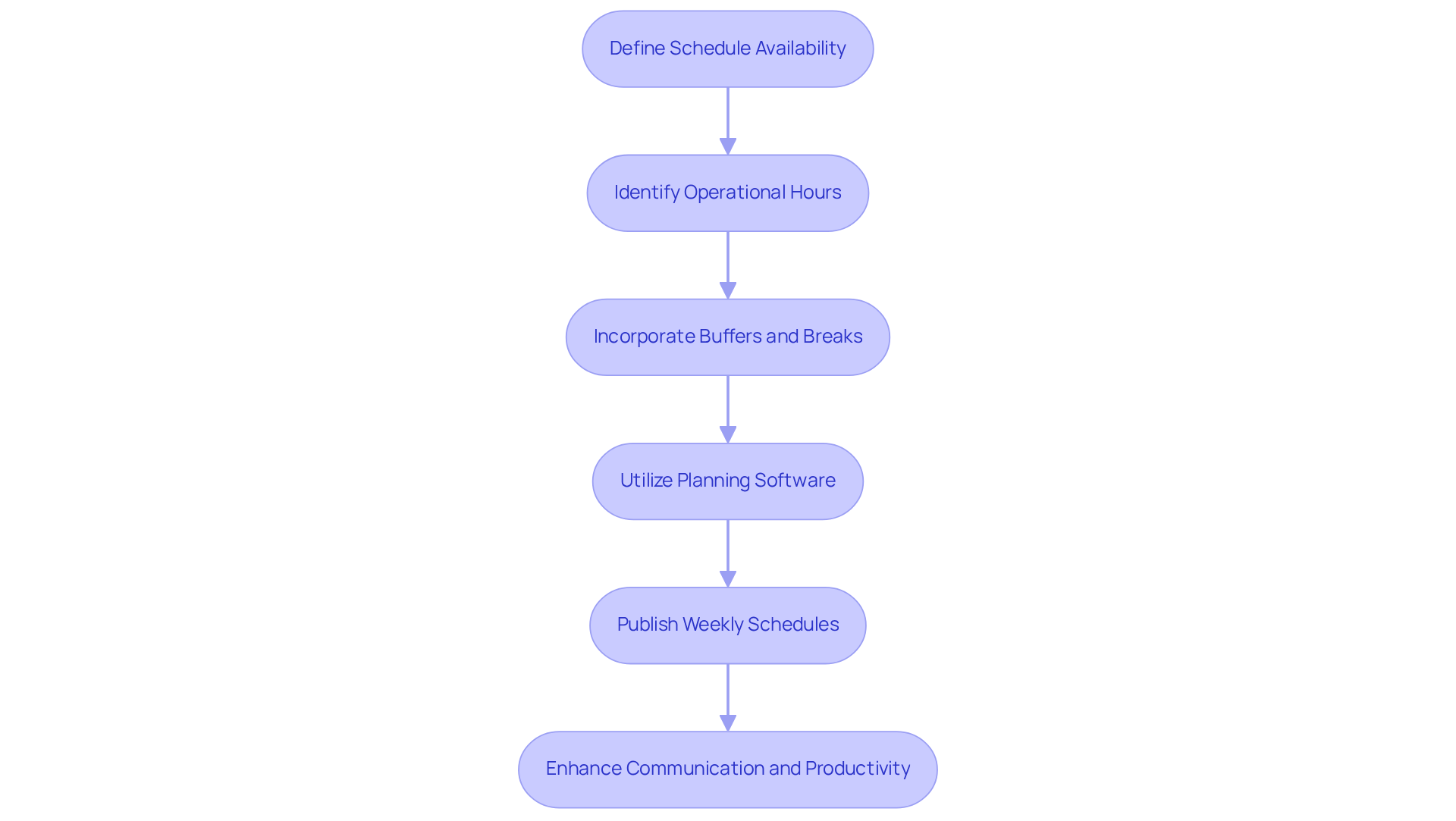
The Importance of Schedule Availability in Organizational Efficiency
Schedule accessibility is crucial for enhancing organizational efficiency. When staff possess clear insights into each other’s schedules, it significantly reduces the time wasted on back-and-forth messaging to find suitable meeting times. This streamlined approach not only conserves valuable time but also fosters a culture of collaboration, enabling teams to swiftly coordinate their schedules for joint projects. Moreover, effective schedule availability enhances resource allocation, enabling managers to assign tasks more accurately based on team members’ availability. Ultimately, this drives productivity and helps achieve strategic goals.
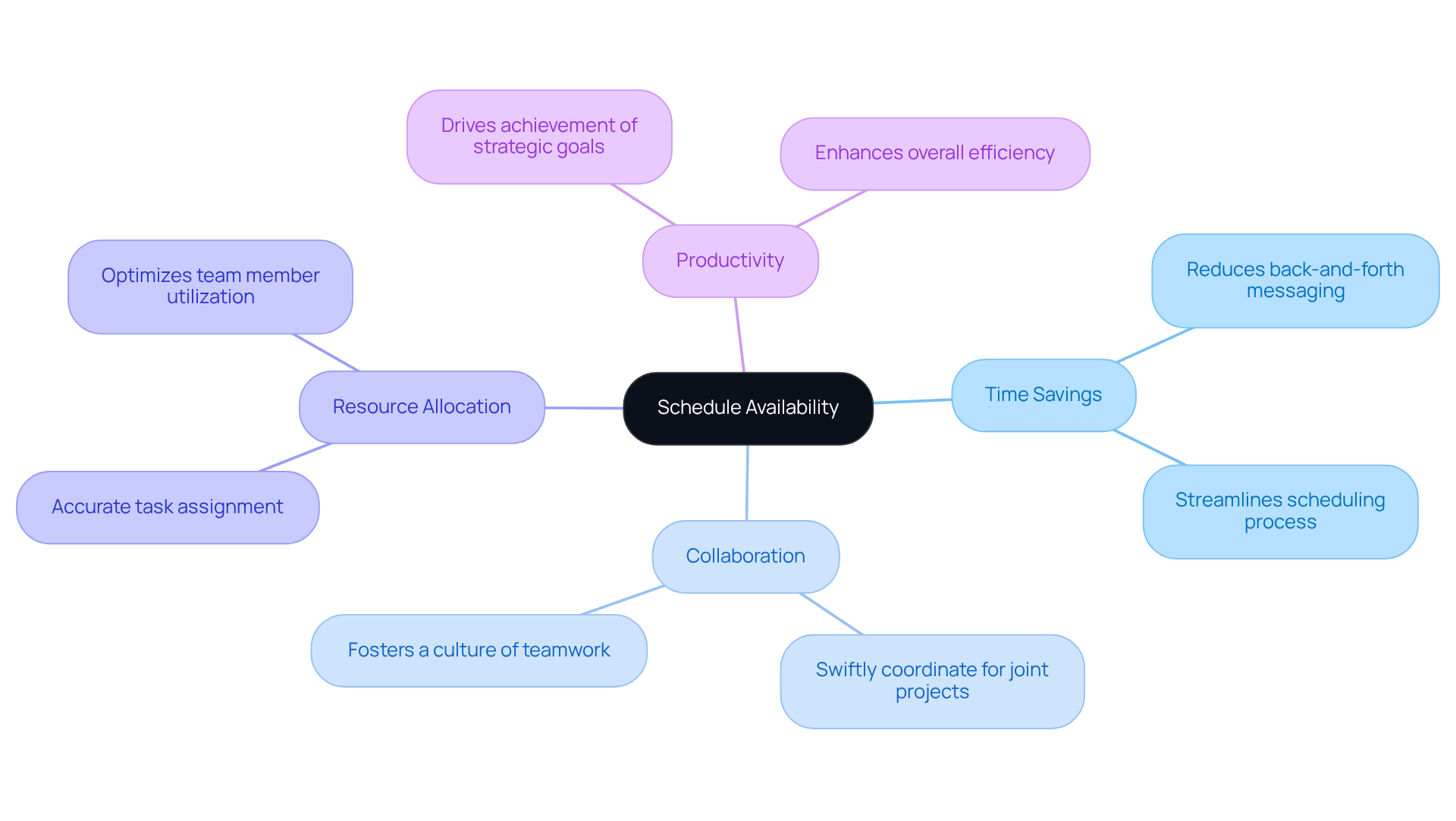
Historical Context of Scheduling Practices
The evolution of planning practices has undergone a substantial transformation, shifting from manual methods to advanced digital tools. Initially, planning relied heavily on physical calendars and paper-based systems, which often led to errors and inefficiencies. As organizations expanded and operational complexities increased, the demand for more effective planning solutions became evident. The introduction of digital calendars and planning software represented a pivotal shift, enabling real-time updates and improved accessibility. Contemporary resources, such as the extension offered by this organization, exemplify the ongoing technological advancements that enhance planning practices. These innovations not only streamline the management of schedule availability but also promote effective collaboration among team members.
Organizations that adopt advanced planning systems have reported a 15-30% reduction in timetable-related attendance issues, clearly demonstrating the tangible benefits of integrating digital tools. Furthermore, the incorporation of AI and machine learning has revolutionized planning, transforming it from a reactive to a predictive process. This allows for optimized distribution methods that take into account factors such as employee preferences and external conditions. AI-driven systems continuously analyze and refine distribution patterns with minimal human intervention, further enhancing planning efficiency. Additionally, organizations utilizing collaborative planning platforms have reported 18-40% higher employee satisfaction scores related to planning, underscoring the importance of employee engagement in modern practices.
This evolution underscores the critical role that digital tools play in enhancing time management efficiency and improving schedule availability in overall workforce administration. By embracing these advancements, organizations can not only improve their operational effectiveness but also foster a more engaged and satisfied workforce.
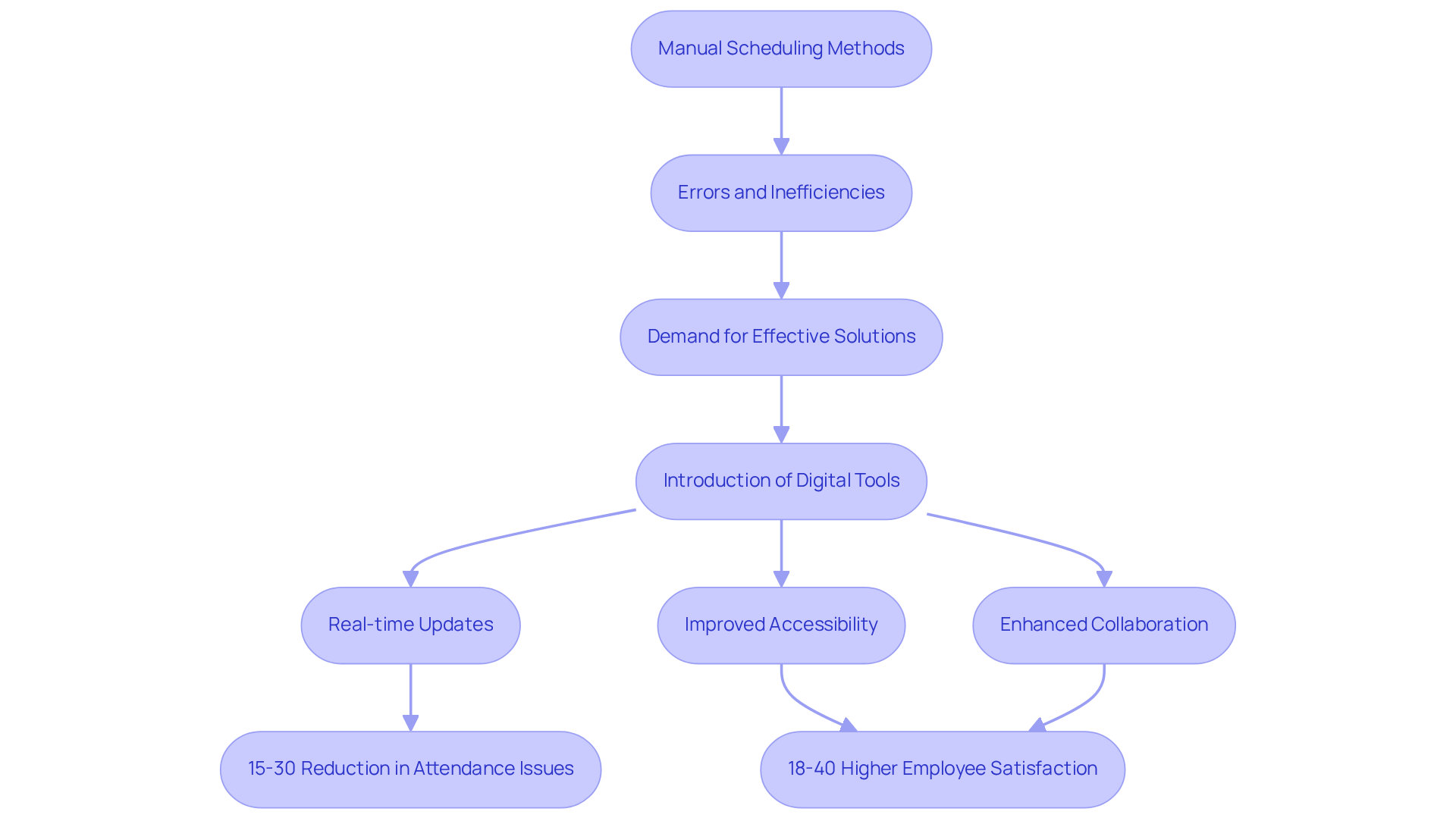
Key Characteristics of Effective Schedule Availability
Effective schedule readiness is characterized by several key traits: clarity, accessibility, and adaptability.
- Clarity ensures that all team members understand each other’s schedule availability, significantly reducing confusion and planning conflicts.
- Accessibility refers to the ease with which individuals can view and update their schedule availability, often facilitated by digital tools that seamlessly integrate with existing calendars.
- Lastly, adaptability is crucial in today’s dynamic work environments; schedule availability must be flexible enough to accommodate changes in priorities or unexpected events.
By focusing on these traits, organizations can establish a more effective planning process, ultimately enhancing collaboration and productivity.
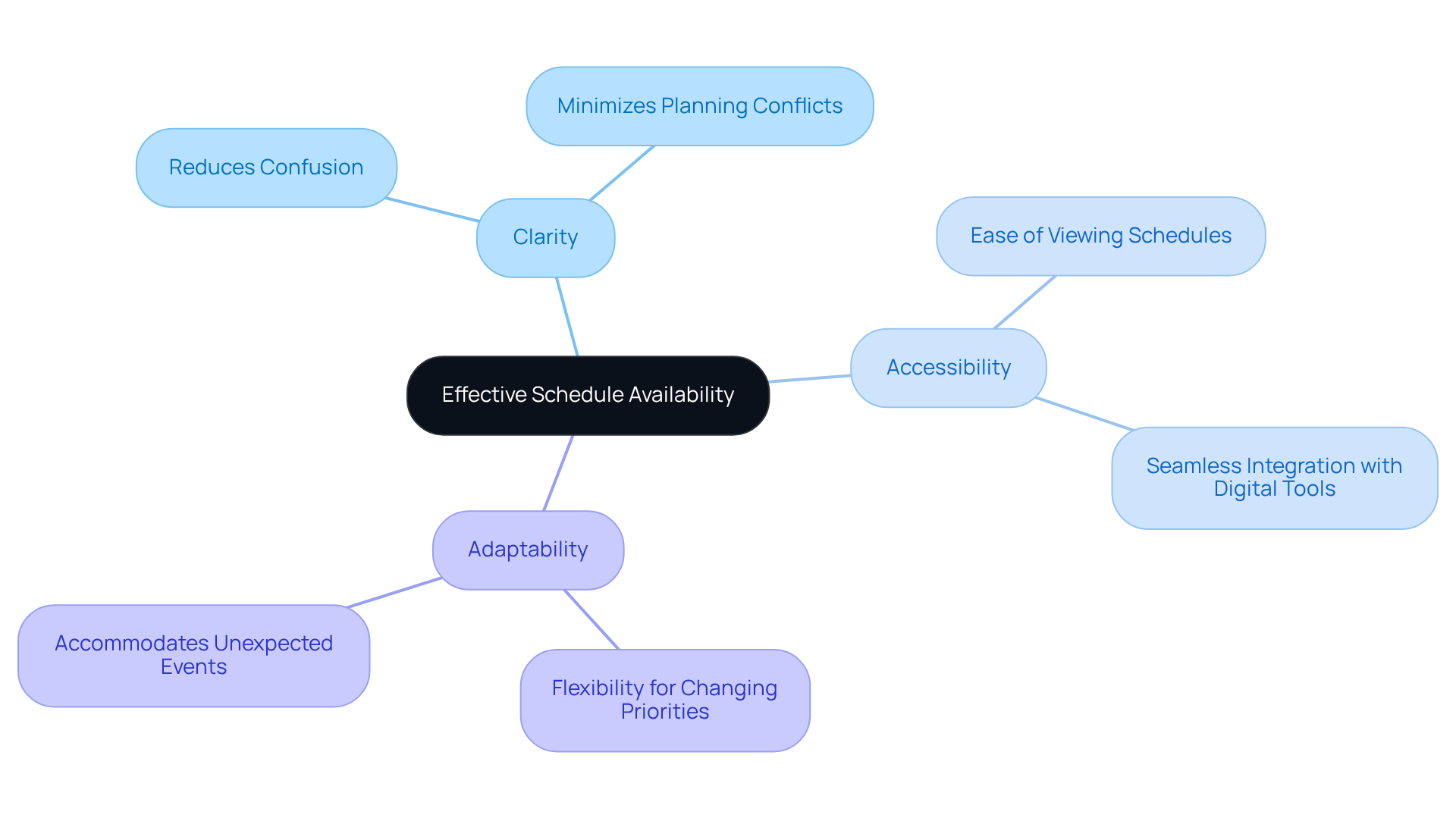
Challenges in Managing Schedule Availability
Managing schedule availability presents significant challenges that can severely hinder productivity and collaboration. Frequent issues arise from miscommunication regarding schedule availability, dependence on outdated planning tools, and the complexities of coordinating across multiple time zones. For instance, teams operating in different regions often struggle to identify their schedule availability, leading to conflicting schedules and project delays.
Research indicates that miscommunication in planning can profoundly impact team dynamics and project outcomes; indeed, time management inefficiencies are causing project-based firms in IT, marketing, and consulting to incur substantial financial losses due to unmonitored billable work. Furthermore, when employees neglect to regularly update their schedule availability, it can result in missed opportunities for collaboration and innovation.
To effectively address these challenges, organizations should invest in user-friendly planning resources like Clockify, a comprehensive solution for tracking time, managing projects, and enhancing overall business efficiency. Such tools not only streamline the planning process but also ensure that all team members are aligned and informed, ultimately fostering a more collaborative work environment.
As Jim Highsmith aptly states, ‘The best way to get a project done faster is to start sooner,’ underscoring the critical importance of timely scheduling and proactive action.
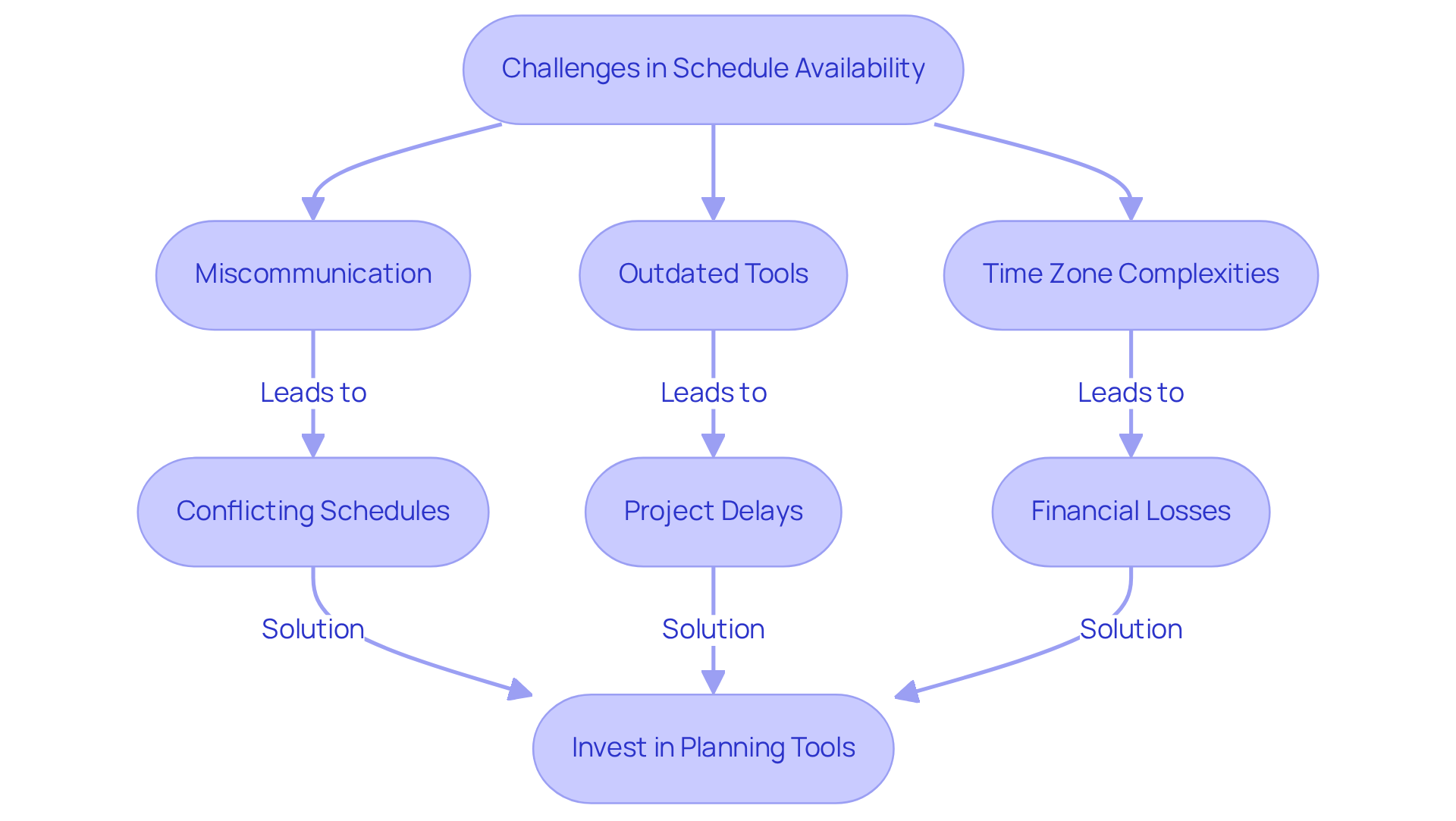
Conclusion
Effective schedule availability stands as a cornerstone in enhancing organizational efficiency and productivity. By clearly defining when individuals or teams are available for collaboration, organizations can significantly minimize communication breakdowns and streamline operations. This structured approach not only fosters a culture of teamwork but also empowers managers to allocate resources effectively, ultimately driving strategic goals forward.
The article presents several compelling arguments supporting the critical role of schedule availability, including its capacity to:
- Reduce wasted time on scheduling conflicts
- Improve resource allocation
- Leverage advanced digital tools for real-time updates
Furthermore, the historical evolution of scheduling practices illustrates the shift from manual methods to innovative digital solutions, underscoring how these advancements contribute to a more engaged and satisfied workforce.
In conclusion, embracing effective schedule availability is essential for any organization striving for operational excellence. By prioritizing clarity, accessibility, and adaptability in scheduling practices, companies can cultivate a collaborative environment that enhances productivity and employee satisfaction. As the landscape of work continues to evolve, organizations must leverage modern tools and strategies to navigate scheduling complexities, ensuring that they remain competitive and responsive to changing demands.
Frequently Asked Questions
What is schedule availability?
Schedule availability refers to the specific times when individuals or teams are available for meetings, tasks, or collaborative efforts. It emphasizes the clarity and accessibility of scheduling information for all stakeholders.
Why is schedule availability important in the workplace?
Schedule availability is crucial for minimizing conflicts, maximizing productivity, enhancing communication, and improving operational efficiency, especially in environments with remote work and flexible hours.
How can organizations improve schedule availability?
Organizations can improve schedule availability by establishing clear time management parameters, such as operational hours and mandatory breaks, and by utilizing planning software for real-time availability updates.
Can you provide an example of effective schedule management?
An example of effective schedule management is a spa that defines its operational hours from 9 AM to 7 PM, includes 15-minute buffers between appointments, and has a mandatory lunch break from 12 PM to 1 PM. This structured approach streamlines appointment management.
What tools can help manage schedule availability?
Tools like the ‘Next Available’ button in Outlook can help manage schedule availability by facilitating effective navigation of time slots and ensuring that team members have access to precise planning information.
How can publishing schedules in advance benefit organizations?
Publishing weekly schedules at least one week in advance can mitigate last-minute conflicts, improve attendance reliability, and cultivate a more collaborative atmosphere, leading to enhanced employee satisfaction and operational success.
How does effective schedule availability impact organizational efficiency?
Effective schedule availability reduces the time wasted on back-and-forth messaging to find suitable meeting times, enhances resource allocation, and drives productivity, ultimately helping organizations achieve their strategic goals.
